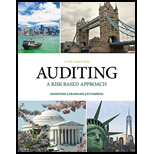
Concept explainers
A
Introduction:
Requirement 1
To calculate : The sample size and sampling interval.
B
Introduction: Misstatement is an error part in the transaction area.
Requirement 2
Analyze each difference detection, if there is misstatement or not.
C
Introduction: Misstatement is defined as the difference between presentation, final amount and classification. The total estimated misstatement is the balance of the account.
Requirement 3
To calculate : Total estimated misstatement of the audit.
D
Introduction:Misstatement is defined as the difference between presentation, final amount and classification. The total estimated misstatement is the balance of the account.
Requirement 4
Discuss the nature of the
Trending nowThis is a popular solution!

Chapter 8 Solutions
Auditing: A Risk Based-Approach (MindTap Course List)
- Swamy Stationery Inc. budgeted production of 64,000 planners in 2023. Paper is required to produce a planner. Assume 95 square yards of paper are required for each planner. The estimated January 1, 2023, paper inventory is 400,000 square yards. The desired December 31, 2023, paper inventory is 370,000 square yards. If paper costs $0.14 per square yard, determine the direct materials purchases budget for 2023.arrow_forwardWhat is the length of the firm's operating cycle?arrow_forwardHelparrow_forward
- At the beginning of the year, a company estimates total direct materials costs to be $800,000 and total overhead costs to be $1,000,000. If the company uses direct materials costs as the allocation base for overhead, what is the predetermined overhead rate it should use during the year?arrow_forwardProvide answerarrow_forwardCan you solve this financial accounting problem with appropriate steps and explanations?arrow_forward
 Auditing: A Risk Based-Approach (MindTap Course L...AccountingISBN:9781337619455Author:Karla M Johnstone, Audrey A. Gramling, Larry E. RittenbergPublisher:Cengage Learning
Auditing: A Risk Based-Approach (MindTap Course L...AccountingISBN:9781337619455Author:Karla M Johnstone, Audrey A. Gramling, Larry E. RittenbergPublisher:Cengage Learning
